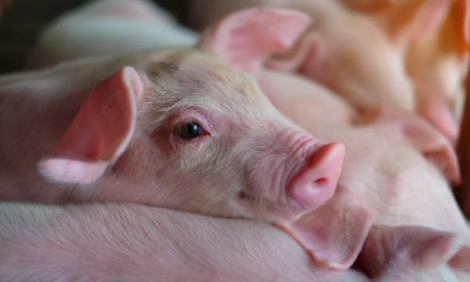



Pig Keeping Guide in the UK
By Defra - Whether you keep one pet pig or a commercial herd of pigs you need to be registered with Defra. This article is a step-by-step guide to register fully with Defra.
In the event of a disease outbreak, the precise location of all livestock is essential for effective measures to control and eradicate highly contagious viruses. You place both your own and other livestock in the area at risk if you do not register your holding or report “notifiable diseases” Please see Annex 4 for a list of notifiable diseases. If you ever have any questions regarding any of these issues then please do not hesitate to contact the Defra Helpline on 0845 050 9876 or your nearest Animal Health Office
BEFORE MOVING A PIG TO YOUR HOLDING:
You need a County Parish Holding number (CPH) for the land where the pigs will be kept
The CPH is a 9 digit number
The first 2 digits relate to the county your pigs are kept in, the next 3 digits relate to the parish and the last 4 digits are a unique number to the keeper. For example, 12/345/6789
To apply for a CPH you need to contact your Rural Development Service office (RDS) – please see annex 1
You will be sent an application form
Complete the application form and return to your RDS office
You will then receive a letter informing you of your CPH number
YOU CAN NOW MOVE THE PIG/S TO YOUR HOLDING
Pig movements will usually take place under a General Licence, which sets out the conditions for movement. You may obtain a copy from the Defra website
(http://www.defra.gov.uk/animalh/movements/pigs/pigs-genlicence.pdf) or from your local Animal Health Divisional Office.Pig movements must be accompanied by the movement document
You will need an Individual Movement Licence to move pigs from a market. This will be issued at the market by a local authority trading standards officer and will also serve as the PRIMO movement document.
In the event of a disease outbreak the AML2 provides traceability because Defra knows where the pigs are and where they have been
The person you are buying the pigs from will be responsible for the providing the AML2 – They are known as the departing address
The departing address completes sections A and C then keeps the yellow copy for their records
The person transporting the pigs then completes section B with their details and keeps the blue copy
The AML2 travels with the pigs • On arrival at your holding you must complete section D with your details
You retain the pink copy of the AML2 for at least 6 months
You must send the white copy to your local trading standards animal health department within 3 days of the pigs arriving
For future movements, please contact your local Animal Health Divisional Office or local trading standards for a tablet of AML2 forms
20 DAY STANDSTILL
Once the pigs arrive on your holding, your holding will be under a standstill
The standstill rules are there to protect against the rapid spread of any new outbreak of disease – the standstill acts as an incubation period and slows down the spread of disease
Pigs trigger a 20 day standstill on other pigs when they move onto a holding
Pigs trigger a 6 day standstill on any cattle, sheep or goats on that holding
Cattle, sheep and goats moving onto a holding will impose a 6 day standstill on any pig on that holding
For more information on livestock movements please ask your local Animal Health Divisional Office for a copy of the Rules for Livestock Movements booklet or visit the website
(http://www.defra.gov.uk/animalh/movements/default.htm).
REGISTER YOUR PIGS
Once the pigs are on your holding you need to register them with Defra
This time you need to contact your local Animal Health Divisional Office (AHDO) – annex 2
You will be asked your CPH number as a reference
Once you inform them you are keeping pigs, they may be able to register them for you over the phone
If your correspondence address is different from the herd location, inform the AHDO and confirm they have the correct details
When your pigs are registered, a herd mark will be automatically created. You may be told this over the phone
Herdmarks for pigs are 1 or 2 letters followed by 4 digits
For example, A1234 or AB1234
The Defra herdmark provides a quick and effective means of identifying premises from which pigs have moved. It is unique, kept on a single database and available to inspectors for rapid tracing
The AHDO will send you a registration document which will contain your personal details, CPH and herdmark
Along with this, you will receive a Welfare of Pigs booklet and a Pig Identification Booklet
If you ever have any questions regarding any of these issues then please do not hesitate to contact your local Animal Health Divisional Office or the helpline on 0845 050 9876
RECORDS
You need to keep an on farm record. This should be in the following format:
| Date of movement | Identification mark, slapmark or temporary mark | Number of pigs | Holding from which moved | Holding to which moved |
| 01/05/04 | Slapmark on both shoulders AB1234 | 5 | My holding Full address CPH |
Mr New holding Full address CPH |
You need to record each movement of a pig on or off the holding within 36 hours of the movement
Once a year you need to record the maximum number of pigs normally present on the holding
These records can be in written or electronic form
You need to keep these records for 6 years after you stop keeping pigs
Your records must be available for inspection by the Local Authority. They may make an on farm visit or may request your records to be sent in for inspection
IDENTIFICATION
You can identify your pig by an eartag, tattoo or double slapmarks. All equipment can be purchased from agricultural suppliers. For a list of suppliers please see annex 3.
Eartag
An eartag must be stamped or printed – not hand written
It contains the letters “UK” followed by your herdmark
For example, UK AB1234
Tags used for slaughter must be metal or flameproof plastic to withstand carcase processing
Tags used for movements between holdings can be plastic
A tattoo of your herdmark on the ear
For example, AB1234
UK not needed
A tattoo of the herdmark which is applied on each front shoulder area of the pig
Legible for the life of the pig and throughout the processing of its carcase
For example, AB1234
UK not needed
Paintmark on the pig – for example, a red line, black cross or blue circle
Must last until the pig reaches its destination
Combined with the movement document, the temporary mark identifies the holding from which the pig moved
Move between holdings with a temporary paintmark
Move to slaughter with an eartag, tattoo or double slapmarks
Move between holdings and to slaughter with an eartag, tattoo or double slapmarks bearing your Defra herdmark

PET PIG WALKING LICENCES
Licences can be issued to take pet pigs for walks
For a licence you need to contact your local Animal Health Divisional Office
Your route will need to be approved
If the Veterinary Officer at the Animal Health Divisional Office believes there is a risk with your route it will not be approved
Routes may not be approved due to proximity to: a livestock market, high health status pig farms or fast food outlets, etc
If it is approved, you are issued with a licence that needs to be renewed annually
FEED ADVICE
It is illegal to feed catering waste or animal by-product to any farmed animal or any other ruminant animal, pig or poultry. The term “catering waste” includes all waste food including used cooking oil originating in restaurants, catering facilities and kitchens, including central kitchens and household kitchens. This definition, therefore, includes all kitchens including kitchens where vegetarian foods are prepared.
The effect of this ban is that you must not feed such material to farm animals, which includes any pig including pet pigs, nor let such animals have access to such material, nor bring such material onto holdings where such animals are kept.
The background to this is that following the outbreak of Foot and Mouth Disease in 2001 the Government reviewed the practice of swill feeding and introduced a ban on the feeding of catering waste that contains, or has been in contact with, meat or meat products to pigs or poultry. Subsequently new EU legislation (1774/2002) on the disposal of animal by-products was introduced in 2002 and it similarly prohibits the feeding of catering waste and any animal by-product. Animal by-products means entire bodies or parts of animals or products of animal origin not intended for human consumption. The Animal By-Products Regulations 2003 provides national legislation for the administration and enforcement of EU Regulation 1774/2002.
No matter how tempting it may be to feed your animals with waste food or material that may contain meat or meat products, please remember that the first confirmed case of the 2001 outbreak of FMD was a holding where waste food was being fed to pigs. Contaminated waste food spreads viruses, such as Foot and Mouth Disease and bacteria, to farmed animals. Infected pigs can quickly infect neighbouring animals.
Your pigs want to be healthy, so help reduce the risk of future outbreaks of diseases by not feeding your pigs catering waste.
Below is a table which sets out the current controls on what may or may not be fed to pigs.

Footnotes
i.e. central, domestic, and commercial kitchens; restaurants and other catering facilities.
e.g. bakeries; distributors; processing and packing plants, retail outlets, but only where meat is not used or handled or where strict HACCP procedures are in place.
providing this material originates either from premises which do not handle products of animal origin other than milk, milk products, eggs, gelatin, rennet or animal fats; or has HACCP procedures in place to ensure that no direct or indirect cross-contamination with products of animal origin can occur.
e.g. biscuits, bread, cakes, chocolate, pastry, sweets etc.
e.g. quiche etc. 6 the use of used cooking oil obtained from approved processors will only be permitted until 31 October 2004.
Please note: Milk and milk products are currently the subject of a proposal which, should it be adopted, would require these products to be further processed before being fed to pigs. Anyone producing pig feed is, therefore, advised to keep in touch with their local animal health office or to regularly check Defra’s Animal By-products internet site for information on this and any other future changes to the controls explained here.
To read the rest of the report, including a list of useful contacts, Click here
Source: Defra - July 2004








